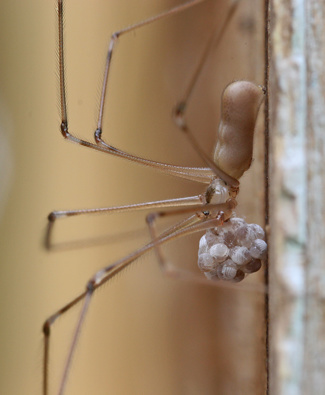People who are not familiar with the Science of naming bugs, plants, animals etc usually give creatures an (often random) “common name”.
“Daddy Longlegs” is used in NZ for three different critters that are found all over the country and frequently encountered; all they have in common is rather long legs, but they belong to totally different animal groups. At this time of the year they are quite common in and around our homes.
1) The Daddy Longlegs spider
Sitting right up there near the ceiling and often in the corner of the corridor, the lounge, or… the bedroom; “EEEEKK!”
I reckon it’s the most vacuumed invertebrate in New Zealand.
Scientists call them “Pholcids” (after the Family name to which these spiders belong); also knows as cellar spiders, because they originally were found to live in cellars and such cave-like spaces where it is damp and dark. A good place to create a website to catch all sorts of flying insects for food. Their job is to function as predators, keeping insect populations “in check”
When Homo sapiens (humans) came along we built our house in their territory and the spiders simply said “thank you” and moved in with us; they catch flies, moths and mosquitoes in their web. They’re on call 24/7 and far more efficient than those chemical-emitting aerosol cans on a timer-system.
These spiders do a few really remarkable things: when the web is disturbed they gyrate their bodies very fast around and around, to put off the web-intruding creature. They make their webs very visible!!
And… a female Pholcid wraps her dozen or so eggs with one single strand of silk and keeps that wrapped parcel in her mouth until the babies hatch – real maternal commitment!! She does not feed herself at all during this time.
2) The Daddy Longlegs Fly
Siting on the external wall of your house – sometimes inside as well (open windows, lights on, attracting these large flies inside!)
They are big flies with a wingspan of over an inch. Three body segments (head, thorax, abdomen) long legs and long transparent wings; it all looks a bit fragile…
Scientists call them Tipulids or “crane flies”. Because they are true insects, they have a life-cycle that involves a complete metamorphosis: egg, larva (maggot), pupa (“chrysalis”) and finally: the adult, winged fly. Flies have only two functional wings (most other insects have four wings).
They have evolved with their hindwings (halteres) shaped like a stalked “counterweight” that gyrates when they fly. It gives them great stability when they fly (a little bit like the tail rotor of a helicopter). When a crane fly sits still on the wall you can see the two halteres clearly.
Adult crane flies often eat nectar (and could be pollinators of flowers); the larvae (maggots known as leatherjackets) usually eat rotting plant material (even dead wood!) and are therefore useful recyclers.
3) Daddy Longlegs Harvestman
Harvestman may look superficially like a spider (it has 8 legs!), but is quite different (it has one body segment (spiders have two) and usually just 2 eyes, often set on a raised mound on their back (spiders 6 to 8 eyes on the front section of their body)
They tend to move across your lawn and through the vegetable garden or in the forests. In New Zealand we have about 30 species that are endemic to New Zealand and 2 “exotics” from Europe. One of those is the “most typical” harvestman Phalagium opilio. Scientists call harvestmans therefore “Opiliones”.
They do a great job in your garden: Harvestman is a predator, eating soft-bodied insects and often plant pests such as aphids and small caterpillars and even the eggs of pests, such as white butterfly eggs. They hunt at night
One of the cool features of these harvestmans is the fact that their second pair of legs is a lot longer than all the other legs. These legs carry some sensitive organs which help the harvestman “navigate” through your garden; think of them as white canes, used by blind persons.
And these same legs also have the ability to absorb a lot more oxygen when they are severed by a predator: it makes them twitch a lot longer, so the predator (a mouse, a rat…) will spend a lot more time and energy with that severed leg, so the harvestman can make a 7 legged escape!
LISTEN ABOVE
Take your Radio, Podcasts and Music with you










